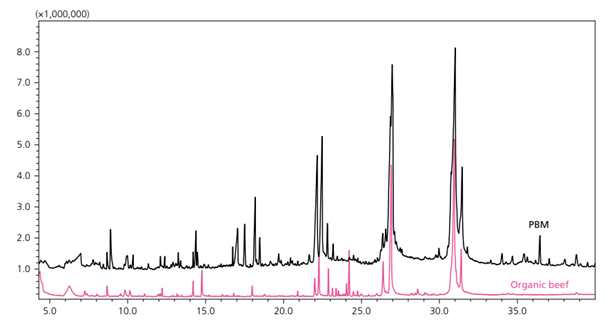
Panel discussion on...
Healthy lifestyle
Welcome in the world of alternative meat: analytical challenges and perspectives

Introduction
1) Over the past 12 months, there has been a noticeable shift in consumer awareness and demands concerning a healthy lifestyle. With a heightened focus on well-being, users are increasingly prioritizing products and services that contribute to their overall health. The global landscape, influenced by ongoing events, has accelerated several trends:
- Digital Health Integration
- Nutritional Choices
- Holistic Wellness
- Sustainability Matters
2) One area that has consistently seen remarkable progress is personalized nutrition. Researchers have been delving into the intricate connections between an individual's genetic makeup, lifestyle, and dietary habits to tailor nutritional recommendations. This personalized approach aims to optimize health outcomes based on specific genetic predispositions, metabolic profiles, and individual preferences.
3) Over the last three years, there has been a discernible trend in the field of health and wellness, with a notable surge in clinical studies focusing on specific health benefit areas. Researchers and healthcare professionals have directed significant attention toward exploring diverse facets of a healthy lifestyle. Some key areas that have witnessed a heightened emphasis include:
Mental Health and Well-Being , Metabolic Health and Nutrition, Aging and Longevity
4) The substantiation of claims is paramount in the decision-making process for consumers considering supplements or health foods. Scientific credibility, coupled with other influencers such as health trends, ingredient transparency, and personalized solutions, collectively shape the choices consumers make to support their health and wellness goals.
5)How do consumer today judge their health status: Please put the following parameter in order. 1 highest priority 7 lowest priority
- Health Tracking Devices and heart rate, sleep patterns, steps taken
- Mental and Emotional Well-being: stress levels, emotional balance, happiness
- Fitness Levels: endurance, strength, flexibility
- Diet and Nutrition: intake of fruits, vegetables, whole grains, proteins
- Quality of sleep: Sleep quality and duration
- Physical Symptoms, like pain, fatigue, constipation, weight gain
- Medical Check-ups: blood pressure checks, cholesterol screenings, blood sugar tests
6) Delivery formats are crucial in supporting consumer compliance in the health and wellness sector, reflecting a brand's technology-driven approach. Today, consumers prioritize not only product efficacy but also ease of incorporation into daily routines. The convenience and effectiveness of delivery formats significantly impact consumer satisfaction and adherence to health regimens. Diverse formats like gummies, powders, liquids, and dissolvable tablets are gaining popularity, aligning with modern preferences for user-friendly choices.
7) Global health concerns include chronic diseases (heart disease, diabetes, hypertension) influenced by lifestyle, mental health issues due to stress and societal pressures, and the escalating problem of obesity linked to unhealthy lifestyles. Infectious diseases persist despite healthcare advancements, emphasized by events like pandemics, highlighting global health interconnectedness. Disparities in healthcare access persist globally, involving inadequate infrastructure and financial barriers. Aging populations pose challenges with increased healthcare demands and age-related diseases. Environmental factors, such as pollution and climate change, impact global health. Regionally, infectious diseases, nutritional challenges, water access, and mental health perceptions vary. Cultural attitudes and genetic factors contribute to diverse health concerns globally. Understanding these shared and unique concerns is crucial for effective public health strategies, considering the complex interplay of cultural, environmental, economic, and healthcare factors.
8) Technology has transformed how we approach health through apps, enabling smarter choices, progress tracking, and personalized lifestyle insights. The synergy between lifestyle apps and supplement brands is notable, offering educational opportunities and influencing consumer choices. Some supplement brands are developing lifestyle apps to enhance user experiences, relying on functionality, engagement, and alignment with brand values for success.
9) The integration of AI into clinical trials is gaining momentum, and consumers are becoming more receptive to claims substantiated through AI-driven research. Collaborations with AI-specialized CROs, application of AI in the discovery phase, and the anticipated role of AI as a manifest tool in clinical trials by 2030 underscore the industry's commitment to leveraging cutting-edge technology for advancing health and wellness precision research.
10) Sustainability is now a key focus in the nutraceutical industry, with consumers seeking brands committed to ethical and environmental values. This approach minimizes waste, preserves resources, and ensures transparent supply chains. The industry is embracing upcycling, turning potential waste into valuable resources. Companies respond by adopting sustainable practices, ethically sourcing raw materials, and creating products that contribute to overall societal and environmental well-being. This shift reflects a holistic approach to health, considering not only individual well-being but also the interconnected health of communities and the planet.
11a) China: Growing emphasis on traditional Chinese medicine, herbal supplements, and overall well-being. Increased interest in beauty-from-within aligns with cultural focus on skincare and beauty.
11b) United States: Trends focus on personalized nutrition, plant-based products, and supplements addressing specific health concerns like immune support. Clean labels and transparency are significant considerations.
11c) Mexico: Trends center on natural and traditional remedies, with demand for supplements promoting energy, weight management, and immune health. Interest in products from local and culturally significant ingredients.
11d) Europe: Diverse claims and dosage forms. Consumers prefer scientifically backed supplements, with a focus on innovative forms like effervescent tablets and gummies. Regulatory compliance is crucial, subject to General Food Legislation Regulation. High segmentation of regulations exists, with countries adopting lists of permitted or prohibited ingredients.
12) Western (EU, USA)
12b) Adult nutrition and prevention of developing disease
What is required to scale-up production of alternative protein sources, such as lab-grown meat and cultivated (breast/bovine) milk?
For the production of 1 kg meat approx. 1 thousand times more water is needed than for 1 kg grain. And furthermore 60% of grain production in Germany is used for feeding cattle and pork.
The development of automated production equipment for tailor-made cultured meat using 3D bioprinting will help to feed the world (4).
The 3D bioprinting technology was developed by Professor Matsusaki of the Osaka University to create muscle tissue structures. This technology is expected to be utilized in the field of food, for production of cultured meat with controlled arrangement of muscle, fat, and blood vessels.
Most of the cultured meats reported so far have a minced structure consisting only of muscle cells, making it difficult to reproduce complex structures. To solve this problem, Matsusaki and co-workers developed a 3D bioprinting technology that uses 3D printing to produce different fibrous tissues (muscle, fat, and blood vessels) and integrates them into a bundle. This technology has made it possible not only to reproduce the famous Wagyu beef, but also to delicately adjust the fat and muscle components. Osaka University and Shimadzu will jointly develop equipment to automate the production of cultured meat using this technology. (5).
What are the most effective methods for enhancing the flavor and texture of alternative proteins?There are meaningful reasons not to go for these new types of foods
Bad experience in terms of taste and texture
Raw meat on its own has little aroma; therefore, almost all aromas associated with “meatiness” are created during the cooking process by the Maillard Reaction between amino acids and reducing sugars. That reaction determines which non-volatile precursors release volatile aroma compounds. Plant-based meat (PBM), products created to resemble animal meat in both look and taste, are growing in popularity. A plant protein such as soy protein concentrate, along with colors, stabilizers, and oils, is used to successfully mimic meat flavor and texture. And, just like in animal meat, the amino acids of that protein undergo the Maillard Reaction.
Samples of PBM were run with the solid phase microextraction GC-MS and the volatile profile was compared against that of the organic beef. Similar compounds, such as fatty acids and Maillard browning reaction products, were found in both types of meat (Figure 1).
The differences can be explained by the different and wide variety of precursors present in PBM since it contains amino acids and sugars from various sources as opposed to regular meat.
There are five basic tastes, including deliciousness, which are perceived by people. The amount and kind of amino acids contribute to taste components. Of all the amino acids, glutamic acid is widely known as a component of the delicious taste. Further, the types and component ratios of amino acids largely control the flavor of food products. For example, glycine and alanine are associated with sweetness, valine and leucine with bitterness, and aspartic acid and glutamic acid with deliciousness.
The texture of food, including the sense of crispness, springiness, firmness, and the feeling on the tongue, is an important element that together with taste has an impact on the deliciousness of food. Food texture is normally evaluated using sensory tests. However, sensory tests are often difficult to reproduce, due to individual differences in people’s sensations and physical condition.
A texture analyzer can support sensory test with objective results in the form of numerical values for use in the field of food development. The texture analyzer evaluates the texture characteristics and allows a comparison of the texture of plant-based meat (PBM) and, for instance, chicken meatballs. Compared to chicken-derived products, plant-based meatballs had a higher force under loading conditions with less elasticity, which is the property to restore deformation (6). It is consistent with the result of the sensory test.

Figure 1. Overlaid Representative Chromatograms for PBM (black) and Organic Beef (pink) (6).
Panelists
References and notes
- Kaplan, A. 2021. Artificial Intelligence (AI): When Humans and Machines Might Have to Coexist. In: Verdegem, P. (ed.) AI for Everyone? Critical Perspectives. Pp. 21–32. London: University of Westminster Press. DOI: https://doi.org/10.16997/book55.b. License: CC-BY-NC-ND 4.0
Questions
1.
2.
3.
4.
5.
How have consumer awareness & demands related to healthy lifestyle changed in the last 12 months?
Where do you see the greatest scientific achievement in nutritional sciences in the last 12 months?
Are there specific health benefit areas in which significant more clinical studies are being done than in others, comparing the last 3 years?
What are the key influencers driving consumer purchasing decision for supplements or health foods? Is substantiation of claims important?
How do consumer today judge their health status?
Please put the following parameter in order 1 highest priority 7 lowest priority:
- Physical Symptoms, like pain, fatigue, constipation, weight gain
- Fitness Levels: endurance, strength, flexibility,
- Health Tracking Devices and heart rate, sleep patterns, steps taken
- Diet and Nutrition: intake of fruits, vegetables, whole grains, proteins.
- Mental and Emotional Well-being: stress levels, emotional balance, happiness
- Quality of sleep: Sleep quality and duration
- Medical Check-ups: blood pressure checks, cholesterol screenings, blood sugar tests
6.
Delivery formats can support consumer compliance and underline the technology driven approach of the brand.
a.
b.
c.
Do you see a consumer trend in preferences for certain delivery formats?
Are delivery format preference a regional, cultural aspect like taste?
Do you see a trend to carry out ingredient clinical trials using a selected delivery format as study product formulation or are most clinical studies still done in capsules?
7.
Consumer health concerns can vary widely across different regions and demographics globally. However, several common health concerns tend to be prevalent across various countries and populations due to globalization, lifestyle changes, environmental factors, and access to information.
a.
b.
Which are the key global consumer health concerns?
Do you see regional differences?
8.
There is a significant increase in the availability of apps and digital platforms focused on healthy lifestyle, particularly to support personalized approaches to mental wellbeing, metabolic support, weight management and physical fitness.
a.
b.
c.
d.
Do you see lifestyle apps as competition for supplement brands?
Do you think that these apps help to educate consumers, being more targeted when searching for supplements?
Did you consider setting up a lifestyle app to promote your supplement or your ingredient?
Did you set up a lifestyle app to promote your supplement/ ingredient and can you explore about your experience and business impact?
9.
AI (Artificial Intelligence) algorithms are today offered for various aspects of clinical trials to proof efficacy of your health ingredient or supplement.
a.
b.
c.
d.
Are consumers looking for substantiation of claims through AI driven clinical trials?
Did you consider working with an CRO specialist in AI to investigate your health ingredient or supplement?
If you applied already AI methods during the discovers/ development of your health ingredient, please share your experience and recommendation with us.
Do you think that in 2030 AI will be a manifest tool for clinical trials?
10.
A healthy lifestyle may also involve a commitment to sustainable practices for both personal and planetary health. This could include supporting ethical and environmentally conscious products.
a.
b.
c.
d.
e.
Do you agree that sustainability has become a growing concern also in the nutraceutical industry?
Are consumer looking proactively for brands which have ethical and environmental principles?
Are you looking for ethically sourced raw materials, ingredients?
Did you implement measures to establish resource-efficient processes?
Are you developing socially useful products and how do you define it?
11.
What are the major geographical differences related to healthy lifestyle trends?
a.
b.
c.
d.
e.
What are the latest trends related to claims and product forms in China?
In the U.S.
In Mexico
How are claims and dosage forms differentiated in Europe? How does your company ensure compliance with health and safety regulations in Europe?
Do you have a country where you would like to speak about trends for products?
12.
Focus clinical studies. Overall, there has been a recognized push for more gender-inclusive, geographical, and target group focused clinical research. The same trend can be seen in clinical trials for supplements or functional foods.
a.
b.
c.
d.
Please select an area you are active in and let us know which is your hot topic ingredients for 2024 for this area, based on substantiated claim, parameters, biomarkers being studied and/ or clinical study being done. Please name ingredients by scientific name and composition and not by brand name.
Please select your geographical area:
Western (EU, USA)
Asia (China, Japan, Asia Pacific)
Americas (Middle and Latin America)
Kids development/ early life nutrition/infant in Western countries and AP
Adult nutrition and prevention of developing disease
Elderly nutrition and how to support quality of life during aging
Sports nutrition, within different life decades and activity levels
References and notes























